
Nipmuc Regional High School

Comic Cuties
Did you read comic books? I did, but only certain ones. It’s blasphemy for sure, but I didn’t care about Superman or Batman … except for the Batmobile … way cool!
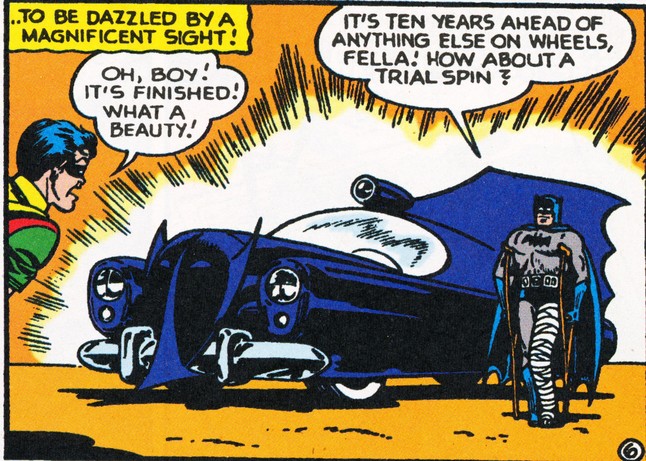
1950 Batmobile
What I did like were the funny comics … or those that mirrored real life. And from those, there were the cuties … the females who starred in their own strips or were the more knowing sidekicks of the male ‘star’.
But first a little history ...
A comic strip is a sequence of drawings arranged in interrelated panels to display brief humor or form a narrative, often serialized, with text in balloons and captions. Traditionally, throughout the 20th century and into the 21st, these were published in newspapers, with horizontal strips printed in black-and-white in daily newspapers, while Sunday newspapers offered longer sequences in special color comics sections. There were more than 200 different comic strips and daily cartoon panels in American newspapers alone each day for most of the 20th century, for a total of at least 7,300,000 episodes.
Storytelling using a sequence of pictures has existed through history. One medieval European example in textile form is the Bayeux Tapestry.
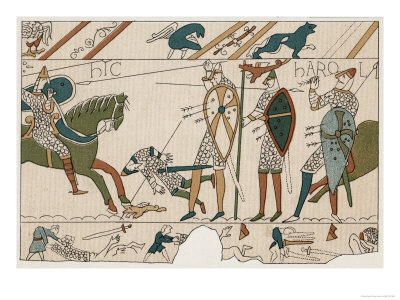
The Battle of Hastings
Printed examples emerged in 19th-century Germany and in 18th-century England, where some of the first satirical or humorous sequential narrative drawings were produced. William Hogarth's 18th century English cartoons include both narrative sequences, such as A Rake's Progress, and single panels.
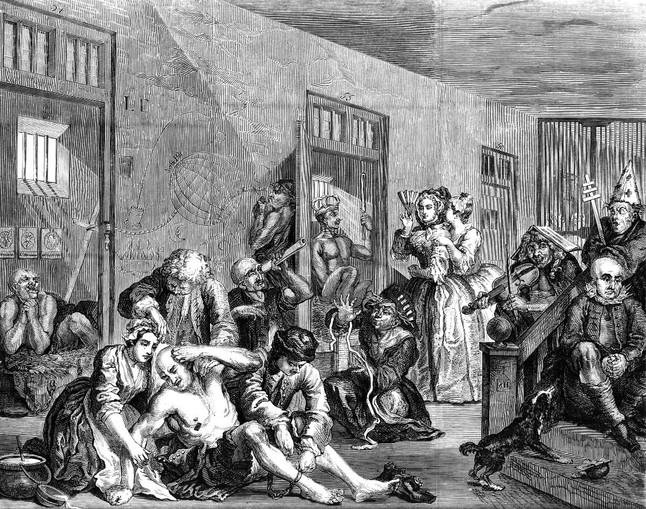
The Biblia pauperum ("Paupers' Bible"), a tradition of picture Bibles beginning in the later Middle Ages, sometimes depicted Biblical events with words spoken by the figures in the miniatures written on scrolls coming out of their mouths—which makes them to some extent ancestors of the modern cartoon strips.

The first newspaper comic strips appeared in America in the late 19th century. The Yellow Kid is usually credited as the first.
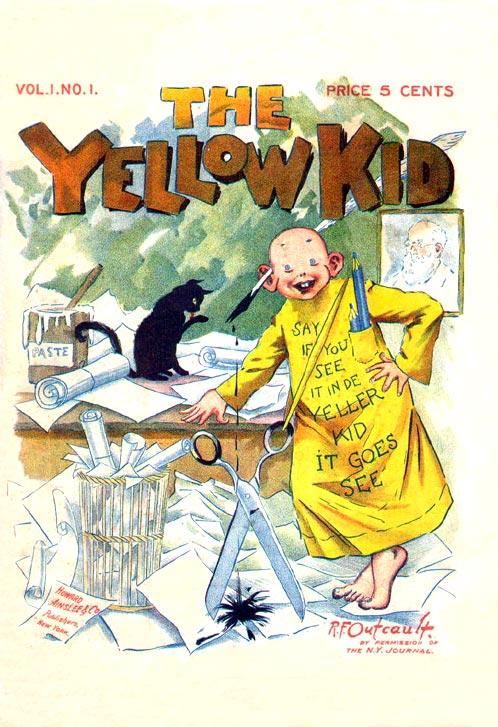
But for the fun stuff, let's travel through time with some of our
Comic Cuties!
Betty Boop
Betty Boop is an animated cartoon character created by Max Fleischer, with help from animators including Grim Natwick. She originally appeared in the Talkartoon and Betty Boop film series, which were produced by Fleischer Studios and released by Paramount Pictures. She has also been featured in comic strips and mass merchandising. Betty Boop was a hit with filmgoers, and despite having been toned down in the mid-1930s, to appear more demure, she became one of the best known cartoon characters in the world, and remains popular today.
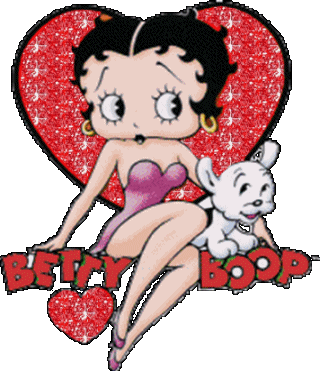
Betty Boop made her first appearance on August 9, 1930, in the cartoon Dizzy Dishes the sixth installment in Fleischer's Talkartoon series. Betty Boop was modeled after superstar actress Clara Bow, the original "It-girl," whose sweet and seductive baby-doll looks were a well-established marquee. The choice of name for the character is built on Bow's three syllable name. Betty Boop was originally created in the mode of an anthropomorphic French poodle.
Max Fleischer finalized Betty Boop as a human character in 1932, in the cartoon Any Rags. Her floppy poodle ears became hoop earrings, and her black poodle nose became a girl's button-like nose. Betty Boop appeared as a supporting character in 10 cartoons, portrayed as a flapper girl with more heart than brains.
.jpg)
Betty Boop is regarded as one of the first and most famous sex symbols on the animated screen;she is a symbol of the Depression era, and a reminder of the more carefree days of Jazz Age flappers. Her popularity was drawn largely from adult audiences, and the cartoons, while seemingly surrealistic, contained many sexual and psychological elements, particularly in the "Talkartoon," Minnie the Moocher, featuring Cab Calloway and his orchestra.
Betty Boop was unique among female cartoon characters in that she represented a sexualized woman. Other female cartoon characters of the same period, such as Minnie Mouse, displayed their underwear or bloomers regularly, in the style of childish or comical characters, not fully defined in a woman's form. Many other female cartoons were merely clones of their male co-stars, with alterations in costume, the addition of eyelashes, and a female voice. Betty Boop wore short dresses, high heels, a garter belt, and her breasts were suggested with a low, contoured bodice that showed cleavage. In her cartoons, male characters frequently try to sneak peeks at her while she's changing or simply going about her business. In Betty Boop's Bamboo Isle, she does the hula wearing nothing but a lei, strategically placed to cover her breasts, and a grass skirt. This was repeated in her first cameo appearance in, Popeye the Sailor (1933). There was, however, a certain girlish quality to the character. She was drawn with a head more similar to a baby's, than an adult's, in proportion to her body. This suggested the combination of girlishness and maturity that many people saw in the flapper type, which Betty was supposed to represent.
Little Lulu
Little Lulu is a comic strip character created by Marjorie Henderson Buell, who debuted in The Saturday Evening Post on February 23, 1935 in a single panel, appearing as a flower girl at a wedding and strewing the aisle with banana peels. Little Lulu replaced Carl Anderson's Henry, which had been picked up for distribution by King Features Syndicate. The Little Lulu panel continued to run weekly in The Saturday Evening Post until December 30, 1944.
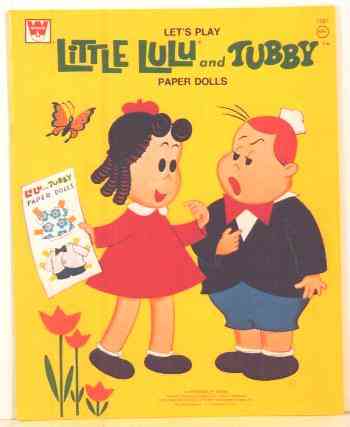
Little Lulu was created as a result of Anderson's success. Schlesinger Library curator Kathryn Allamong Jacob wrote, "Lulu was born in 1935, when The Saturday Evening Post asked Buell to create a successor to the magazine’s Henry, Carl Anderson’s stout, mute little boy, who was moving on to national syndication. The result was Little Lulu, the resourceful, equally silent (at first) little girl whose loopy curls were reminiscent of the artist’s own as a girl. Buell explained to a reporter, 'I wanted a girl because a girl could get away with more fresh stunts that in a small boy would seem boorish.'"
A daily comic strip, entitled Little Lulu, was syndicated from June 5, 1950 through May 1969.
Nancy
Nancy is an American daily and Sunday comic strip, originally written and drawn by Ernie Bushmiller.
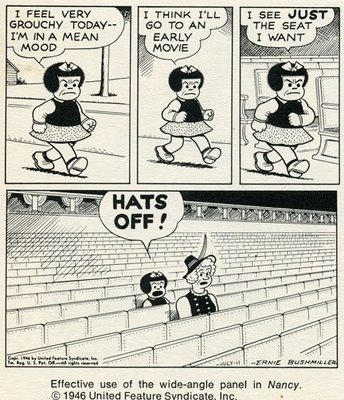
The character of Nancy, a slightly chubby and precocious eight-year-old, first appeared in the strip Fritzi Ritz about the airheaded flapper title character. Larry Whittington began Fritzi Ritz in 1922, and it was taken over by Bushmiller three years later.
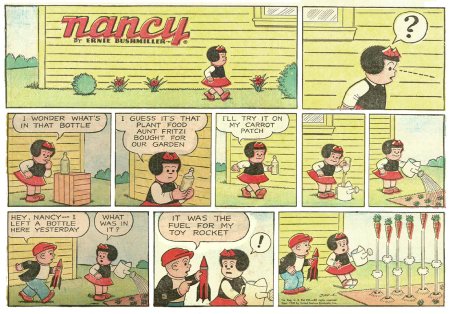
On January 2, 1933, Bushmiller introduced Fritzi's niece, Nancy. Soon she dominated the strip, retitled Nancy in 1938. Fritzi Ritz continued as a Sunday feature until 1968. At its peak in the 1970s, Nancy ran in more than 880 newspapers.
Margaret - Dennis the Menace
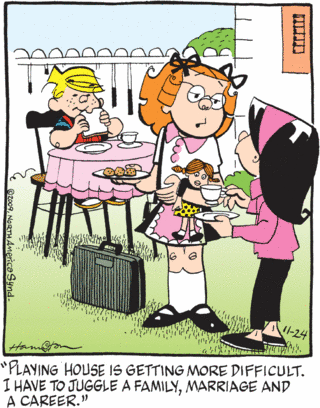
Margaret Wade - a freckled, red-haired, bespectacled know-it-all whose cloying and self-important demeanor is always getting on Dennis’ nerves. She is attracted to Dennis and is stubbornly confident in the belief that she will marry him when they are adults, but he will have none of it because Dennis clearly has no interest in her. She always tries to improve Dennis and his manners, but only succeeds in annoying him. She has a certain amount of dislike for Gina, whom she sees as her competition. Gina gains Dennis's respect and admiration by just being herself and Margaret's pretensions fail to make a mark on him.
Cathy
Cathy was a comic strip drawn by Cathy Guisewite. It featured a woman who struggled through the "four basic guilt groups" of life — food, love, mom, and work — the strip gently poked fun at the lives and foibles of modern women. Cathy's characteristics and issues both made fun of and sometimes fed into negative stereotypes about women. The strip debuted on November 22, 1976, and at its peak appeared in over 1,400 newspapers. The strips have been collected into more than 20 books. Guisewite received the National Cartoonists Society Reuben Award in 1992 for the strip.
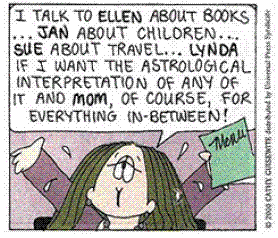
Initially, the strip was based largely on Guisewite's own life as a single woman. However, Guisewite had Cathy's longtime boyfriend Irving propose marriage on Valentine's Day 2004. The two characters married in the February 5, 2005 strip. That same year, Cathy appeared in the 75th anniversary party of Blondie and Dagwood. On August 11, 2010, Cathy Guisewite announced the decision to end the run of Cathy. On October 3, 2010, the final strip ran, with the revelation that Cathy is pregnant with a baby girl.
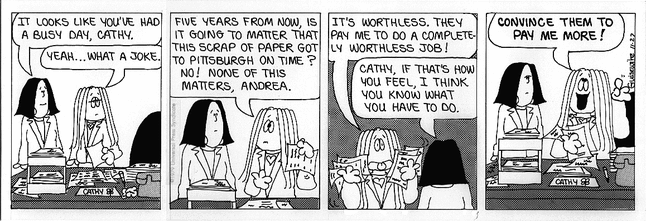
Blondie
Blondie is an American comic strip created by cartoonist Chic Young. Distributed by King Features Syndicate, the strip has been published in newspapers since September 8, 1930.[1] The success of the strip, which features a well-endowed blonde and her sandwich-loving husband, led to the long-running Blondie film series (1938–1950) and the popular Blondie radio program (1939–1950). Chic Young drew Blondie until his death in 1973, when creative control passed to his son Dean Young, who continues to write the strip. Young has collaborated with a number of artists on Blondie, including Jim Raymond, Mike Gersher, Stan Drake, Denis Lebrun and currently, John Marshall. Through these changes, Blondie has remained popular, appearing in more than 2000 newspapers in 47 countries and translated into 35 languages.
On February 17, 1933, after much fanfare and build-up, Blondie Boopadoop marries her boyfriend Dagwood Bumstead, the son of a wealthy industrialist. Unfortunately, Dagwood's upper-crust parents strongly disapprove of his marrying beneath his class, and disinherit him. The check Dagwood uses to pay for his honeymoon bounces, and the Bumsteads are forced to become a middle-class suburban family. Blondie’s marriage marked the beginning of a change in her personality. From that point forward, she gradually assumed her position as the sensible head of the Bumstead household. And Dagwood, who previously had been cast in the role of straight man to Blondie’s comic antics, took over as the comic strip’s clown.

The Bumstead family grows with the addition of a son named Alexander (originally "Baby Dumpling") on April 15, 1934, a daughter named Cookie on April 11, 1941, a dog, Daisy, and her litter of five unnamed pups. In the 1960s, Cookie and Alexander grew into teenagers (who uncannily resemble their parents), but they stopped growing during the 1960s when Young realized that they had to remain teenagers to maintain the family situation structured into the strip for so many decades.
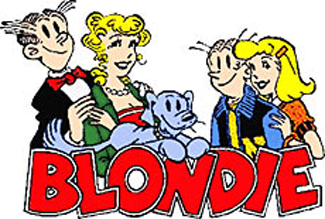
Peanuts Girls
Sally Brown is the younger sister of Charlie Brown in the comic strip Peanuts by Charles Schulz. She was first mentioned in early 1959 and throughout a long series of strips before her first appearance in August 1959.
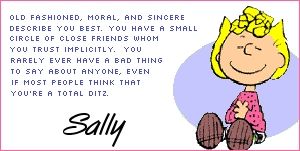
Sally has flipped blonde hair with a cluster of curls and sometimes a bow in front, and she wears a polka dot dress, usually pink or light blue. In the winter, and most of the time in the later years of the strip, she switched to a shirt and pants. She has a "take it easy" approach to life, preferring to slide by while doing as little work as possible. Her favorite pastime is sitting in her beanbag chair watching TV. In a series of strips from 1982, Sally actually went to "beanbag camp", which consisted of nothing but lazing around in beanbags, watching TV and gorging on junk food, and returned home fat. She can be stubborn sometimes, and is usually convinced she's right until someone proves her wrong, but she also has a good heart and a strong moral sense; like her older brother she is extremely sensitive to the unfairness of life. Charlie Brown usually goes to Lucy in her psychiatric booth when he's feeling depressed, but Sally prefers to confide her troubles to the school building, which is very protective of her and will drop a brick on anyone who doesn't treat her nicely.
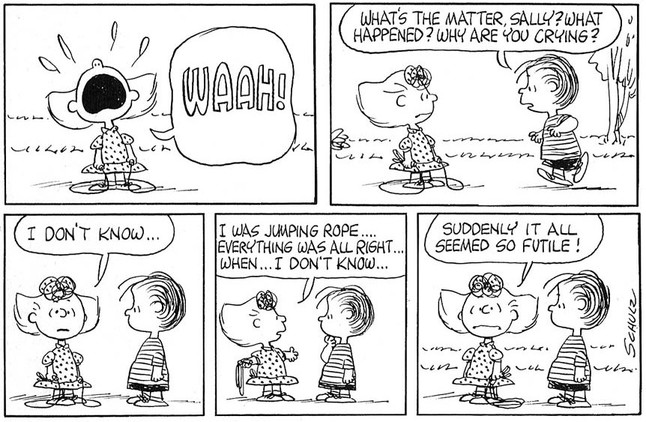
In the later years of the strip, Sally also frequently developed "new philosophies" on life, which were typically short sayings or phrases with little or no philosophical value, such as "We'll always have Minneapolis" (a take on the famous line "We'll always have Paris" from the film Casablanca), "Who cares?", "Why me?", and "How should I know?" One time, Sally declared that her new philosophy was simply the word "No", which was to be her answer to every question from that moment on, but then Charlie Brown caught her off guard with a question to which she responded, "Yes!", leading her to grumble, "You ruined my new philosophy." The late 1990s Broadway revival of You're a Good Man, Charlie Brown made reference to this with a new song for Sally (portrayed by Kristin Chenoweth) called "My New Philosophy."
https://www.youtube.com/watch?v=060nwhVzzlw
Sally has a lot of trouble with malapropisms, both in speech and writing (for example, "violins breaking out" rather than "violence breaking out," or "controversial French" instead of "conversational French" or being streched out instead of being stressed out- in the latter example, once Charlie Brown pointed out Sally's error, she lost all interest in taking the class). One of the strip's running jokes is the unintentionally humorous school reports she gives at the front of the class, which are frequently inspired by malapropisms and end with her feeling humiliated as all of her classmates laugh at her. Some of the more memorable reports she has given over the years include "Santa and his Rain Gear", "Handbidextrous" people, and "The Bronchitis", or her report on the oceans of the world, then proceeding to state that there are no oceans in individual landlocked states in the U.S. She often struggles with homework despite Charlie Brown's patient efforts to help her, and she has a particular dislike for math, which she largely finds both intimidating and incomprehensible. However, she has expressed interest in becoming a nurse once she becomes an adult (although this is due to her interest in wearing white shoes, as opposed to the job itself).
Lucy van Pelt is a regular character in the Peanuts cartoon and TV specials. She is the older sister of Linus and Rerun. Lucy was introduced into the strip on March 3, 1952 as a wide-eyed baby who constantly tormented her parents. Very early on, Schulz eliminated the circles around her eyes and allowed her to mature to the age of the other characters. She soon grew into her familiar persona of a bossy, crabby, selfish girl.
Lucy wears a blue-colored dress with white and black saddle shoes for most of the strip's original run. However, in later years, towards its end, she was seen more in a pink dress, until her dress was phased out altogether.
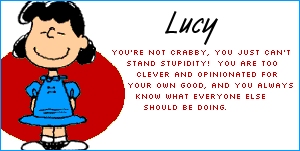
Perhaps Lucy's most famous gimmick in her long existence as a character is the one in which she pulls the football away from Charlie Brown right as he is about to kick it. The first occasion on which she did this was November 16, 1952, taking over for Violet, who had previously subjected Charlie Brown to this trick on November 14, 1955, for fear that Charlie Brown would accidentally kick her instead of the ball. Afterward, Lucy would always intentionally pull the football away from Charles Brown to trick him. The most infamous example of this is the animated special It's Your First Kiss, Charlie Brown, where her actions cost the football team the Homecoming game, yet Charlie Brown is blamed even though he is clearly not at fault. It became so bad, that later showings edited that part out.
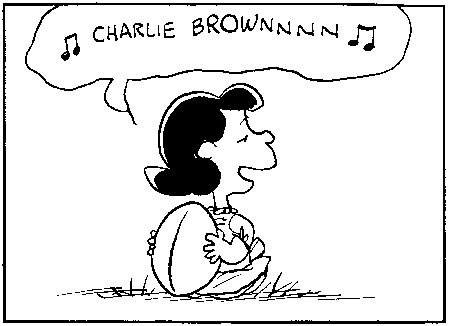
For all her crabbiness and bad temper, Lucy did have a romantic side: she was in love with Schroeder, but he did not return the affection. In this Lucy is seen as insecure, as she shows a need for assurance from Schroeder and Charlie Brown that she is pretty (constantly asking them of their opinion of her appearance), and is known to react harshly when she receives an unfavorable, or even hesitant, answer. Indeed, Lucy seems to be rather thin-skinned when it comes to being insulted herself; once, when Linus countered her statement that he was a terrible brother by saying that she was not such a great sister either, Lucy burst into tears. Another time, her reaction to Charlie Brown's telling her she was not perfect was to storm off angrily without even a word, leaving Charlie Brown to comment, "I've never seen anyone so insulted!"
Little Lotta
Little Lotta is a fictional character published by Harvey Comics from 1953 to 1972, and then sporadically until 1993. A contemporary of Little Audrey, Little Dot and Wendy the Good Little Witch, she was one of Harvey's best-known female characters during the 1960s and featured in many of the company's child-friendly comedy titles. Like many of Harvey's comic headliners, Lotta was notable for a 'quirky' defining characteristic - in this case, an insatiable appetite giving rise to superhuman strength.
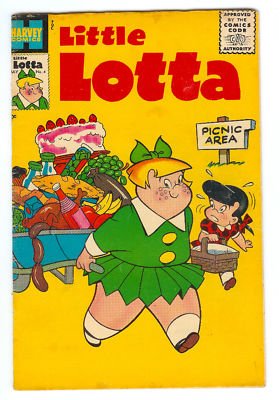
Lotta Plump first appeared in 1953 as a backpage feature in Little Dot (where she debuted with Harvey's most successful property, Richie Rich). From the outset, Lotta's dietary habits were a running gag employed in virtually every story and featured prominently on the covers of her two comic titles, Little Lotta (1955-1972, 1974-76; 1992-1993) and Little Lotta in Foodland (1962-1968). A typical cover scene typically displayed Lotta devouring a meal of gigantic proportions or performing some feat of tremendous strength.
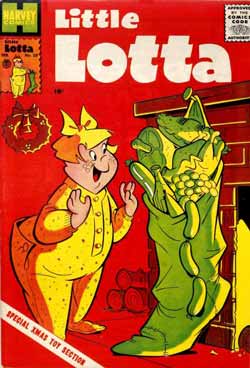
Far from being the 'unpopular fat kid' stereotype represented in other popular media (such as contemporary Tubby in Little Lulu) Lotta was depicted as friendly, kind-hearted and always ready to use her tremendous strength for what she deemed as good. She has her share of bullying, but any tormentors quickly regret instigating her wrath. In a sense, Lotta's storylines fulfill two very common childhood fantasies: the satisfaction of visceral desires (eating everything in sight) and freedom through physical power.
Minnie Mouse
Minnie Mouse is an animated character created by Ub Iwerks and Walt Disney. The comic strip story "The Gleam" (published January 19-May 2, 1942) by Merrill De Maris and Floyd Gottfredson first gave her full name as Minerva Mouse. Minnie has since been a recurring alias for her. Both Minnie and Mickey were first drawn in 1928 by Ub Iwerks.
.jpg)
The comic strip story "Mr. Slicker and the Egg Robbers" (published September 22 – December 26, 1930) introduced her father Marcus Mouse and her mother Margie Mouse, both farmers. The same story featured photographs of her grandparents Marshall Mouse and Matilda Mouse. Her best known relatives, however, remain her uncle Mortimer Mouse and her twin nieces, Millie and Melody Mouse, though most often a single niece, Melody, appears. In many appearances, Minnie is presented as the girlfriend/wife of Mickey Mouse, a close friend of Daisy Duck, Donald Duck's girlfriend/wife, and occasionally a friend to Clarabelle Cow. Minnie's sister, Mandie Mouse was a recurring character early on.
Daisy Duck
Daisy Duck is one of Walt Disney's cartoon and comic book characters. She was created as a female counterpart and girlfriend to Donald Duck, and first appeared in the cartoon "Mr. Duck Steps Out" in 1940. Daisy has Donald's temper but has far greater control of it (although on rare occasions, her temper can burst out and she can get into rages similar to Donald's), and tends to be more sophisticated than her boyfriend. She usually wears either no pants herself or a dress.
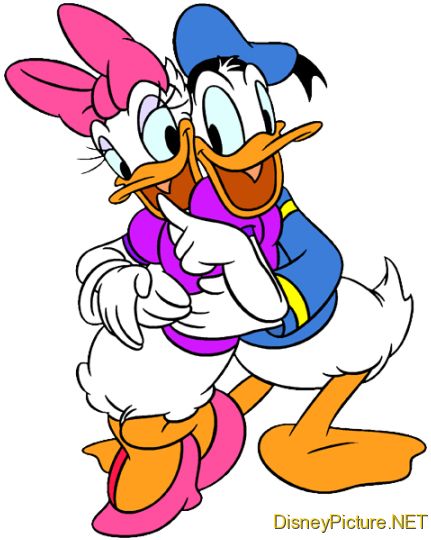
She is mostly shown as showing a strong affinity towards Donald.
Daisy replaced (or, according to some sources, represents a later form of) a short-lived early love interest named Donna Duck, who first appeared in the cartoon "Don Donald" in 1937. In a short 1951 comic strip continuity, Donna returned, reconceived into an unrelated Mexican girl duck who functioned as a rival for Donald's affections.
Daisy is the aunt of triplets April, May, and June Duck, who serve as Huey, Dewey, and Louie's female counterparts. In some appearances, Daisy is presented as a close friend of Minnie Mouse.
Olive Oyl
Olive Oyl is a cartoon character created by Elzie Crisler Segar in 1919 for his comic strip Thimble Theatre. The strip was later renamed Popeye after the sailor character that became the most popular member of the cast; however Olive Oyl was a main character for 10 years before Popeye's 1929 appearance.
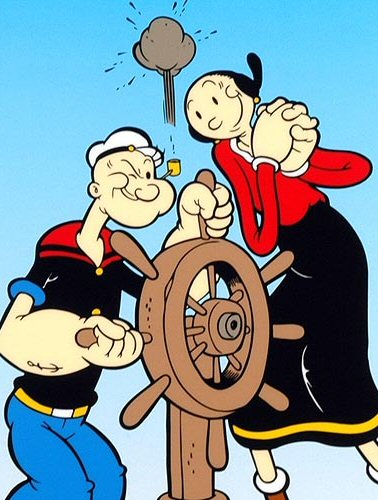
In the strip as written by Segar, Olive was something of a coy flapper who’s extremely thin build lent itself well to the fashions of the time; her long black hair was usually rolled in a neat bun, like her mother's. She was the more-or-less fiancée of Harold Hamgravy, a "lounge lizard" or slacker type who did as little work as possible and was always borrowing money. His attraction to other women—particularly if they were rich—naturally incensed Olive, and she once succumbed to a fit of "lunaphobia" (a kind of angry madness) over one of his amours. (When she recovered, she continued to pretend to have the disorder to win him back.) She was not immune to flattery from other men, but remained committed to Ham until Popeye's appearance. The two did not fall in love at once (her first words to him were "Aw, shut up, you bilge rat!"), but instead fought bitterly (and hilariously) for weeks, before realizing they cared for each other.
The version of Olive Oyl most widely familiar is the version from the theatrical animated cartoons, first created by Fleischer Studios, and then produced by Famous Studios. Unlike most modern damsels in distress, Olive Oyl is tall and skinny, with tightly wound hair and enormous feet (the latter sometimes used to comedy effect). Popeye's comment about her measurements is that she is a perfect 57... 19-19-19. In more recent years, her breast size has been somewhat of a joke on other cartoon shows, suggesting that Olive Oyl should receive breast implants.
.gif)
In the films and later television cartoons, Olive Oyl is Popeye's girlfriend, although she could be extremely fickle, depending on who could woo her best or had the flashier possessions, and was prone to get angry over the tiniest things. She constantly gets kidnapped by Bluto (aka Brutus), who is Popeye's archrival for her affections, but Popeye always rescues her, winning her affection in the end.
Little Orphan Annie
Little Orphan Annie was a daily American comic strip created by Harold Gray (1894–1968) and syndicated by Tribune Media Services. The strip took its name from the 1885 poem "Little Orphant Annie" by James Whitcomb Riley, and made its debut on August 5, 1924 in the New York Daily News. It ranked number one in popularity in a Fortune poll in 1937.
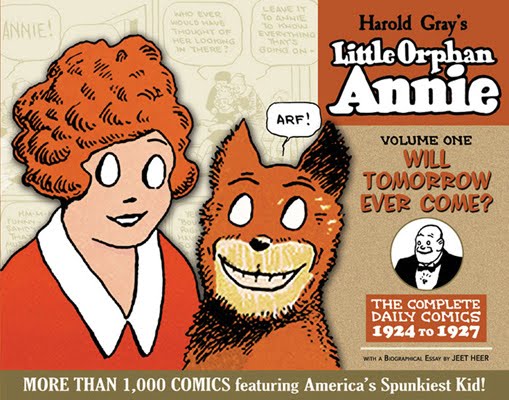
The plot follows the wide-ranging adventures of Annie, her dog Sandy, and her benefactor Oliver "Daddy" Warbucks. Secondary characters include Punjab, the Asp and Mr. Am. The strip attracted adult readers with political commentary that targeted (among other things) organized labor, the New Deal and communism.
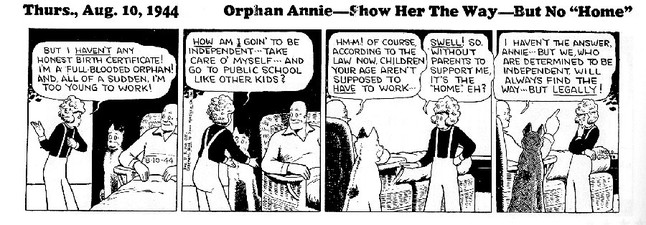
Following Gray's death in 1968, several artists drew the strip and, for a time, "classic" strips were rerun. Little Orphan Annie inspired a radio show in 1930, film adaptations by RKO in 1932 and Paramount in 1938 and a Broadway musical Annie in 1977. The strip's popularity declined over the years and was running in only 20 newspapers when it was cancelled on June 13, 2010.
Annie is an orphan of no definite age, perhaps between ten and twelve. Her distinguishing physical characteristics are a mop of red, curly hair, a red dress and vacant circles for eyes. Her catch phrases are "Gee whiskers" and "Leapin' lizards!" Annie attributes her lasting youthfulness to her Leap Day, February 29, birthday, and so only ages one year in appearance for every four years that pass. Annie is a plucky, generous, compassionate and optimistic youngster who can hold her own against bullies and has a strong and intuitive sense of right and wrong.
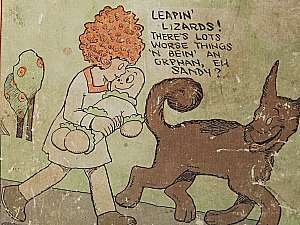
The sun will come out ... tomorrow!
See you in the funny papers!




